An Improved Grey Model and Scenario Analysis for Carbon Intensity Forecasting in the Pearl River Delta Region of China
Abstract
:1. Introduction
2. Literature Review
2.1. The Forecasting of Carbon Emissions
2.2. Grey Prediction Models
2.3. Genetic Algorithms
3. Model and Methodology
3.1. GM(1,1) Model
3.2. GM(1,N) Model
3.3. The Modelling Algorithm of GA-GM(1,N)
4. Materials
4.1. Data and Source
4.2. Calculation of Carbon Emissions and Carbon Intensity
4.3. Correlations between the Reference Sequence and the Comparison Sequences
4.4. Forecasting Scenarios
5. Results and Discussion
5.1. Training and Testing
5.2. Comparative Analysis of Forecasting
5.3. Analysis of Reduction Rate Based on Different Development Scenarios
6. Conclusions
- (1)
- During the period covered by the Thirteenth Five-Year Plan, all three prediction models suggest that both carbon intensity and its variation will decline. The reduction in carbon intensity will continue, but decrease.
- (2)
- Among the three grey models, the lowest prediction errors were given with GA-GM(1,N) at both the training and the testing stages, which indicates that the prediction accuracy of a multivariate grey model is improved by using a genetic algorithm. The newly proposed genetic algorithm is an attractive and effective optimization tool for carbon intensity forecasting.
- (3)
- Under all three scenarios, of the nine cities only Guangzhou could achieve its reduction target. It could serve as a reference or pattern for low-carbon development for other cities, particularly those that are likely to fail to meet their targets, such as Foshan, Zhaoqing, Zhuhai, Huizhou and Jiangmen. Due to the contribution of its low-carbon cities, Pearl River Delta could take the lead in achieving the reduction task of Guangdong Province under the “Base development scenario” and “High development scenario”.
Acknowledgments
Author Contributions
Conflicts of Interest
References
- De Richter, R.K.; Ming, T.; Caillol, S.; Liu, W. Fighting global warming by GHG removal: Destroying CFCs and HCFCs in solar-wind power plant hybrids producing renewable energy with no-intermittency. Int. J. Greenh. Gas Control 2016, 49, 449–472. [Google Scholar] [CrossRef]
- Available online:https://data.worldbank.org.cn/indicator/EN.ATM.CO2E.PP.GD?view=map (accessed on 3 November 2017).
- Jalil, A.; Mahmud, S.F. Environment Kuznets curve for CO2, emissions: A Cointegration analysis for China. Energy Policy 2009, 37, 5167–5172. [Google Scholar] [CrossRef]
- Liao, F.H.F.; Wei, Y.D. Dynamics, space, and regional inequality in provincial China: A case study of Guangdong province. Appl. Geogr. 2012, 35, 71–83. [Google Scholar] [CrossRef]
- Available online:http://www.gdstats.gov.cn/tjnj/2016/directory/content.html?02-15 (accessed on 3 November 2017).
- Yi, W.J.; Zou, L.L.; Jie, G.; Kai, W.; Wei, Y.M. How can China reach its CO2, intensity reduction targets by 2020? A regional allocation based on equity and development. Energy Policy 2011, 39, 2407–2415. [Google Scholar] [CrossRef]
- Clough, S. Achieving CO2, reductions in Colombia: Effects of carbon taxes and abatement targets. Energy Econ. 2016, 56, 575–586. [Google Scholar]
- Qiang, D.; Ning, W.; Lei, C. Forecasting China’s per capita carbon emissions under a new three-step economic development strategy. J. Resour. Ecol. 2015, 6, 318–323. [Google Scholar] [CrossRef]
- Wu, Q.; Peng, C. Scenario analysis of carbon emissions of China’s electric power industry up to 2030. Energies 2016, 9, 988. [Google Scholar] [CrossRef]
- Sun, W.; Wang, C.; Zhang, C. Factor analysis and forecasting of CO2 emissions in Hebei, using extreme learning machine based on particle swarm optimization. J. Clean. Prod. 2017, 162, 1095–1101. [Google Scholar] [CrossRef]
- Zhu, B.; Wang, K.; Chevallier, J.; Wang, P.; Wei, Y.M. Can China achieve its carbon intensity target by 2020 while sustaining economic growth? Ecol. Econ. 2015, 119, 209–216. [Google Scholar] [CrossRef]
- Xiao, B.; Niu, D.; Guo, X. Can China achieve its 2020 carbon intensity target? A scenario analysis based on system dynamics approach. Ecol. Indic. 2016, 71, 99–112. [Google Scholar] [CrossRef]
- Wang, R.; Liu, W.; Xiao, L.; Jian, L.; Kao, W. Path towards achieving of China’s 2020 carbon emission reduction target—A discussion of low-carbon energy policies at province level. Energy Policy 2011, 39, 2740–2747. [Google Scholar] [CrossRef]
- Yu, B.; Li, X.; Qiao, Y.; Shi, L. Low-carbon transition of iron and steel industry in China: Carbon intensity, economic growth and policy intervention. J. Environ. Sci. 2015, 28, 137–147. [Google Scholar] [CrossRef] [PubMed]
- Cansino, J.M.; Román, R.; Rueda-Cantuche, J.M. Will China comply with its 2020 carbon intensity commitment? Environ. Sci. Policy 2015, 47, 108–117. [Google Scholar] [CrossRef]
- Kayacan, E.; Ulutas, B.; Kaynak, O. Grey system theory-based models in time series prediction. Expert Syst. Appl. 2010, 37, 1784–1789. [Google Scholar] [CrossRef]
- Zhou, P.; Ang, B.W.; Poh, K.L. A trigonometric grey prediction approach to forecasting electricity demand. Energy 2006, 31, 2839–2847. [Google Scholar] [CrossRef]
- Zhao, Z.; Wang, J.; Zhao, J.; Su, Z. Using a grey model optimized by differential evolution algorithm to forecast the per capita annual net income of rural households in China. Omega 2012, 40, 525–532. [Google Scholar] [CrossRef]
- Wang, J.; Yan, R.; Hollister, K.; Zhu, D. A historic review of management science research in China. Omega 2008, 36, 919–932. [Google Scholar] [CrossRef]
- Ding, S.; Dang, Y.-G.; Li, X.-M.; Wang, J.-J.; Zhao, K. Forecasting Chinese CO2, emissions from fuel combustion using a novel grey multivariable model. J. Clean. Prod. 2017, 162, 1527–1538. [Google Scholar] [CrossRef]
- Akay, D.; Atak, M. Grey prediction with rolling mechanism for electricity demand forecasting of Turkey. Energy 2007, 32, 1670–1675. [Google Scholar] [CrossRef]
- Liu, X.; Cuartas, B.M.; Muñiz, A.S.G. A grey neural network and input–output combined forecasting model. Primary energy consumption forecasts in Spanish economic sectors. Energy 2016, 115, 1042–1054. [Google Scholar] [CrossRef]
- Deng, J.L. Grey Prediction and Decision; HUST Press: Wuhan, China, 2002. (In Chinese) [Google Scholar]
- Guo, H.; Xiao, X.; Forrest, J. A research on a comprehensive adaptive grey prediction model CAGM(1,n). Appl. Math. Comput. 2013, 225, 216–227. [Google Scholar] [CrossRef]
- Wang, Z.X.; Hao, P. An improved grey multivariable model for predicting industrial energy consumption in China. Appl. Math. Model. 2016, 40, 5745–5758. [Google Scholar] [CrossRef]
- Canyurt, O.E.; Ozturk, H.K. Application of genetic algorithm (GA) technique on demand estimation of fossil fuels in Turkey. Energy Policy 2008, 36, 2562–2569. [Google Scholar] [CrossRef]
- Hong, W.C.; Dong, Y.; Zhang, W.Y.; Chen, L.Y.; Panigrahi, B.K. Cyclic electric load forecasting by seasonal with chaotic genetic algorithm. Int. J. Electr. Power Energy Syst. 2013, 44, 604–614. [Google Scholar] [CrossRef]
- Holland, J.H. Adaptation in Natural and Artificial Systems; MIT Press: London, UK, 1992. [Google Scholar]
- Zhang, K.; Du, H.; Feldman, M.W. Maximizing influence in a social network: Improved results using a genetic algorithm. Phys. A Stat. Mech. Appl. 2017, 478, 20–30. [Google Scholar] [CrossRef]
- Gao, M.; Shi, G.; Li, W.; Wang, Y.; Liu, D. An improved genetic algorithm for island route planning. Procedia Eng. 2017, 174, 433–441. [Google Scholar] [CrossRef]
- Zamzamian, S.M.; Hosseini, S.A.; Samadfam, M. Optimization of the Marinelli beaker dimensions using genetic algorithm. J. Environ. Radioact. 2017, 172, 81–88. [Google Scholar] [CrossRef] [PubMed]
- Benet, C.H.; Kassler, A.; Zola, E. Predicting expected TCP throughput using genetic algorithm. Comput. Netw. 2016, 108, 307–322. [Google Scholar] [CrossRef]
- Yuan, J.L.; Li, X.Y.; Zhong, L. Optimized Grey RBF Prediction Model Based on Genetic Algorithm. In Proceedings of the International Conference on Computer Science and Software Engineering, Wuhan, China, 2008; pp. 74–77. [Google Scholar]
- Ou, S.L. Forecasting agricultural output with an improved grey forecasting model based on the genetic algorithm. Comput. Electron. Agric. 2012, 85, 33–39. [Google Scholar] [CrossRef]
- Choi, J.W.; Lee, H.; Lee, J.C.; Lee, S.; Kim, Y.S.; Yoon, H.; Kim, H.C. Application of genetic algorithm for hemodialysis schedule optimization. Comput. Methods Programs Biomed. 2017, 145, 35–43. [Google Scholar] [CrossRef] [PubMed]
- Deng, J.L. Control problems of grey systems. Syst. Control Lett. 1982, 1, 288–294. (In Chinese) [Google Scholar]
- Bhattacharyya, S.C.; Ussanarassamee, A. Decomposition of energy and CO2, intensities of Thai industry between 1981 and 2000. Energy Econ. 2004, 26, 765–781. [Google Scholar] [CrossRef]
- Li, J.; Lin, B. Inter-factor/inter-fuel substitution, carbon intensity, and energy-related CO2, reduction: Empirical evidence from China. Energy Econ. 2016, 56, 483–494. [Google Scholar] [CrossRef]
- Zhang, W.; Li, K.; Zhou, D.; Zhang, W.; Gao, H. Decomposition of intensity of energy-related CO2, emission in Chinese provinces using the LMDI method. Energy Policy 2016, 92, 369–381. [Google Scholar] [CrossRef]
- Kadier, A.; Abdeshahian, P.; Simayi, Y.; Ismail, M.; Hamid, A.A.; Kalil, M.S. Grey relational analysis for comparative assessment of different cathode materials in microbial electrolysis cells. Energy 2015, 90, 1556–1562. [Google Scholar] [CrossRef]
- Yuan, Z.; Wu, L.; Yuan, Z.; Li, H. Shape optimization of welded plate heat exchangers based on grey correlation theory. Appl. Therm. Eng. 2017, 123, 761–769. [Google Scholar]
- Kolonko, M. A generalized crossover operation for genetic algorithms. Complex Syst. 1995, 9, 177–191. [Google Scholar]
- Junior, A.R.L. A study for multi-objective fitness function for time series forecasting with intelligent techniques. In Proceedings of the Conference Companion on Genetic and Evolutionary Computation, Atlanta, GA, USA, 12–16 July 2008; ACM: New York, NY, USA, 2008; pp. 1843–1846. [Google Scholar]
- Liao, Z.; Zhu, X.; Shi, J. Case study on initial allocation of Shanghai carbon emission trading based on Shapley value. J. Clean. Prod. 2015, 103, 338–344. [Google Scholar] [CrossRef]
- Pao, H.T.; Fu, H.C.; Tseng, C.L. Forecasting of CO2, emissions, energy consumption and economic growth in China using an improved grey model. Energy 2012, 40, 400–409. [Google Scholar] [CrossRef]
- Lewis, C.D. Industrial and Business Forecasting Methods: A Practical Guide to Exponential Smoothing and Curve Fitting; Butterworth Scientific, Heinemann: London, UK, 1982. [Google Scholar]
- Wang, Z.; Zhang, B.; Liu, T. Empirical analysis on the factors influencing national and regional carbon intensity in China. Renew. Sustain. Energy Rev. 2016, 55, 34–42. [Google Scholar] [CrossRef]
- Yu, S.; Zhang, J.; Zheng, S.; Sun, H. Provincial carbon intensity abatement potential estimation in China: A PSO–GA-optimized multi-factor environmental learning curve method. Energy Policy 2015, 77, 46–55. [Google Scholar] [CrossRef]
- Zhao, X.; Zhang, X.; Li, N.; Shao, S.; Geng, Y. Decoupling economic growth from carbon dioxide emissions in China: A sectoral factor decomposition analysis. J. Clean. Prod. 2017, 142, 3500–3516. [Google Scholar] [CrossRef]
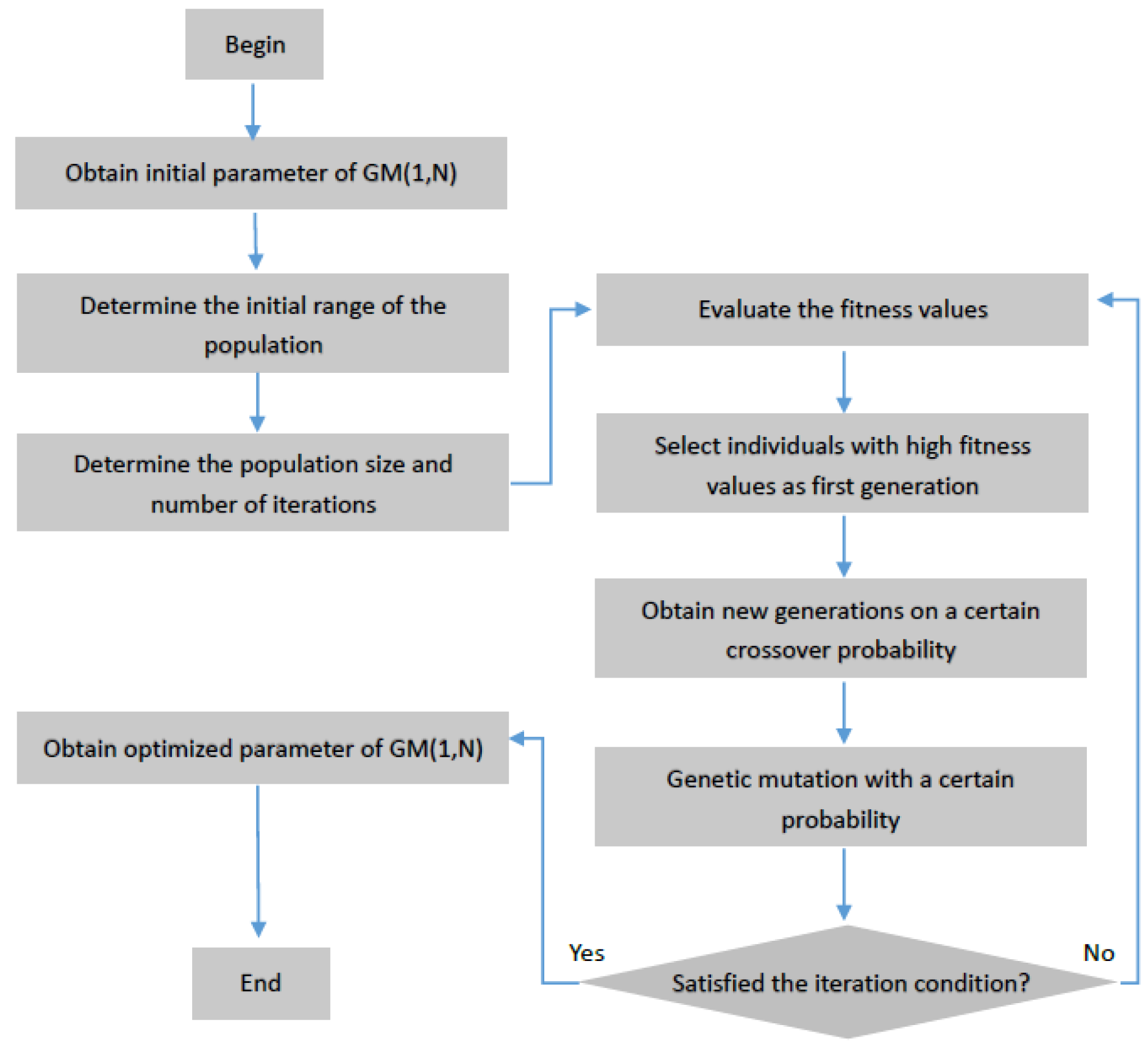
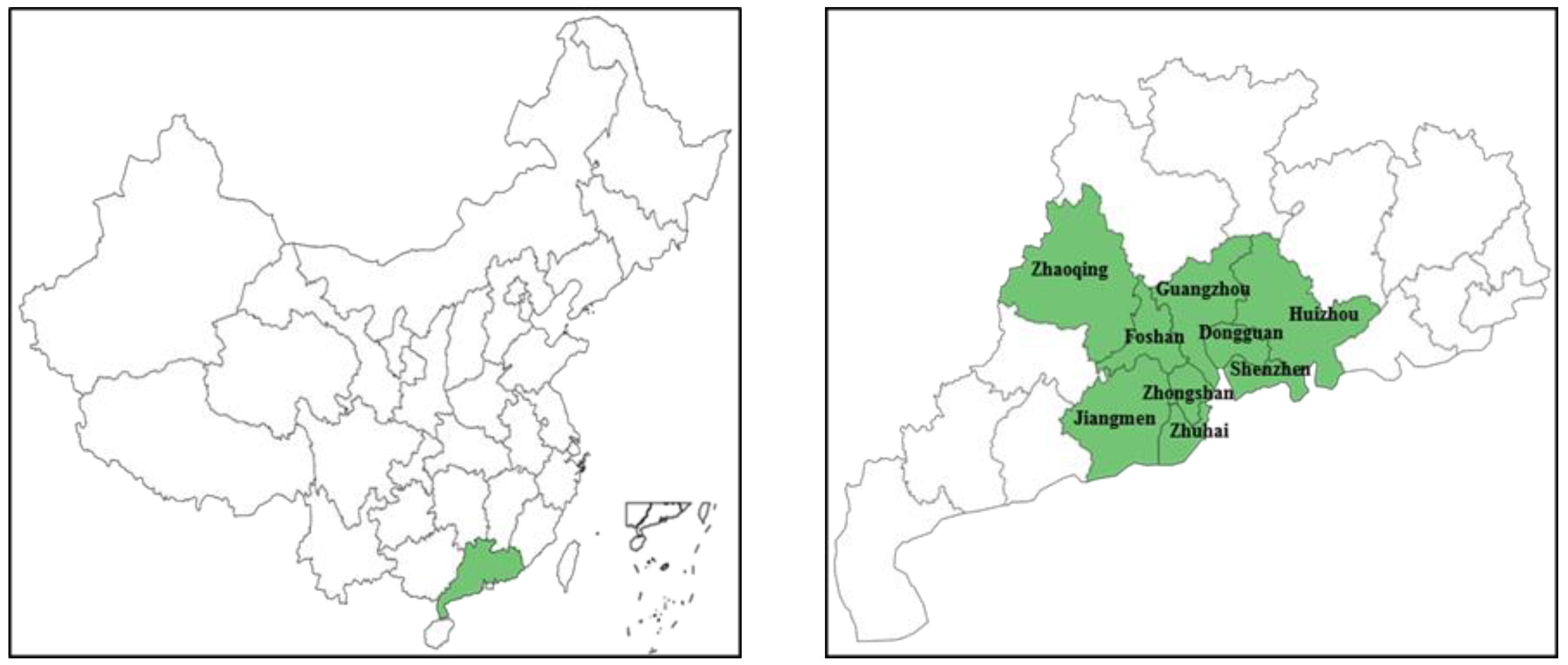
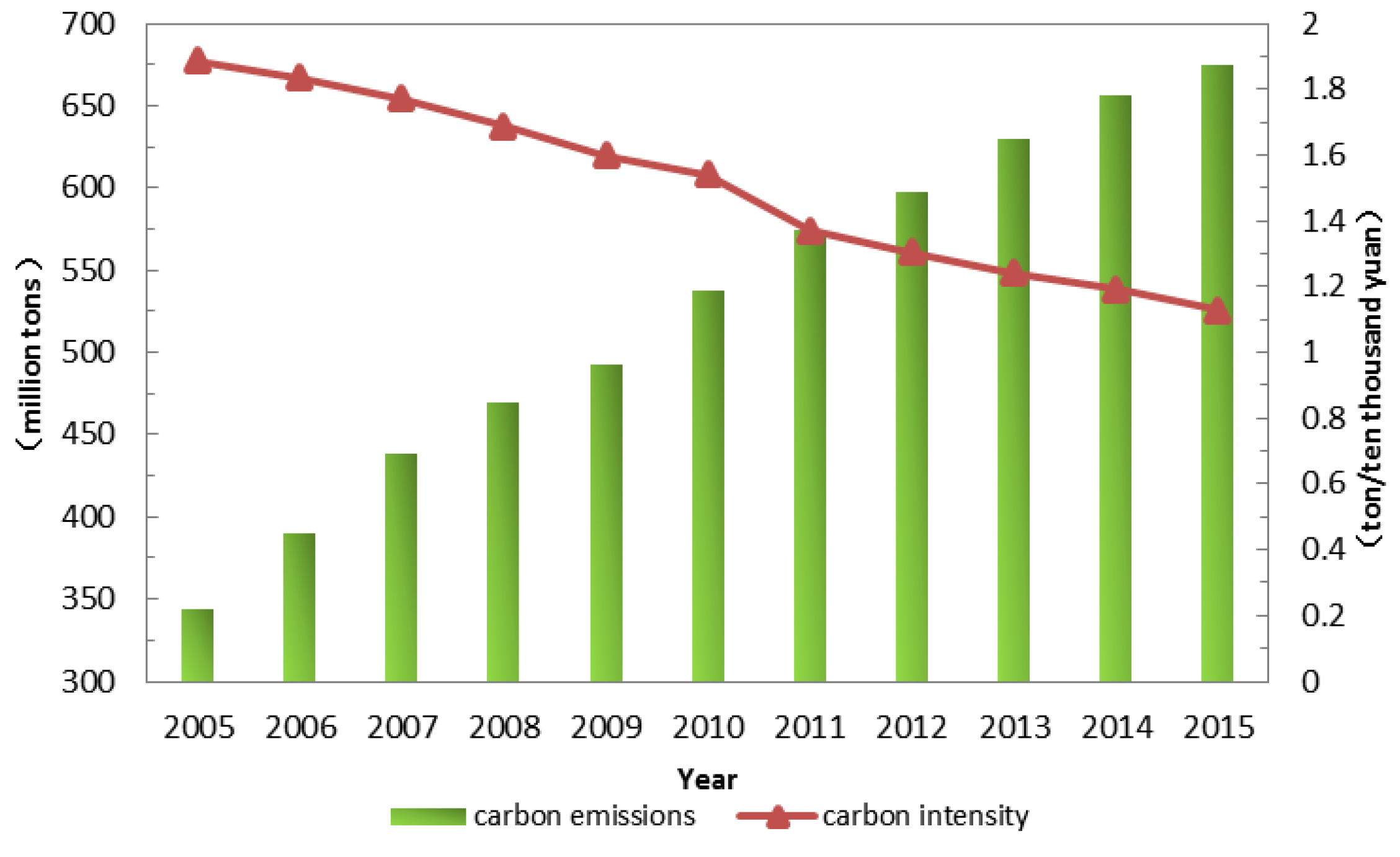
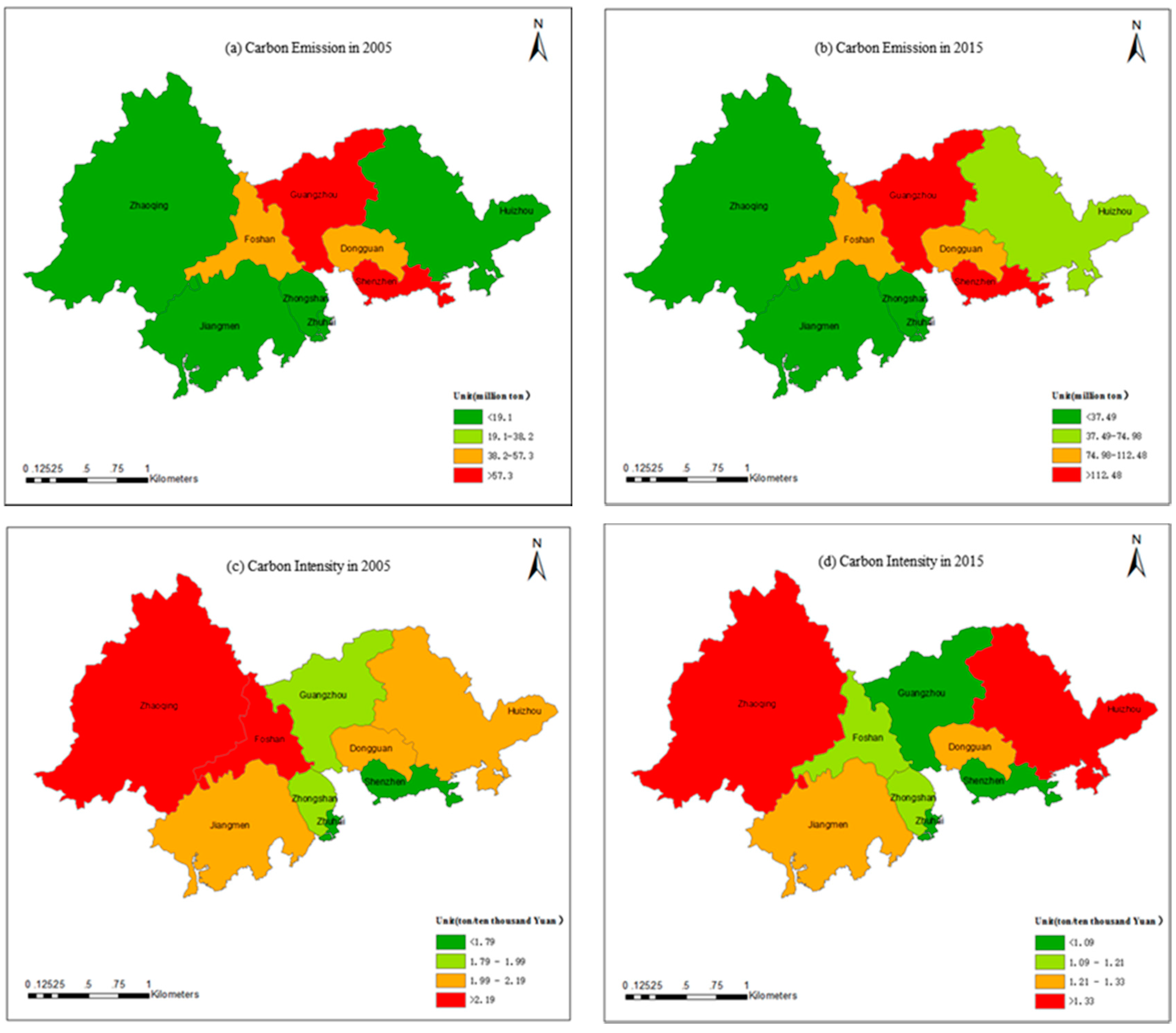
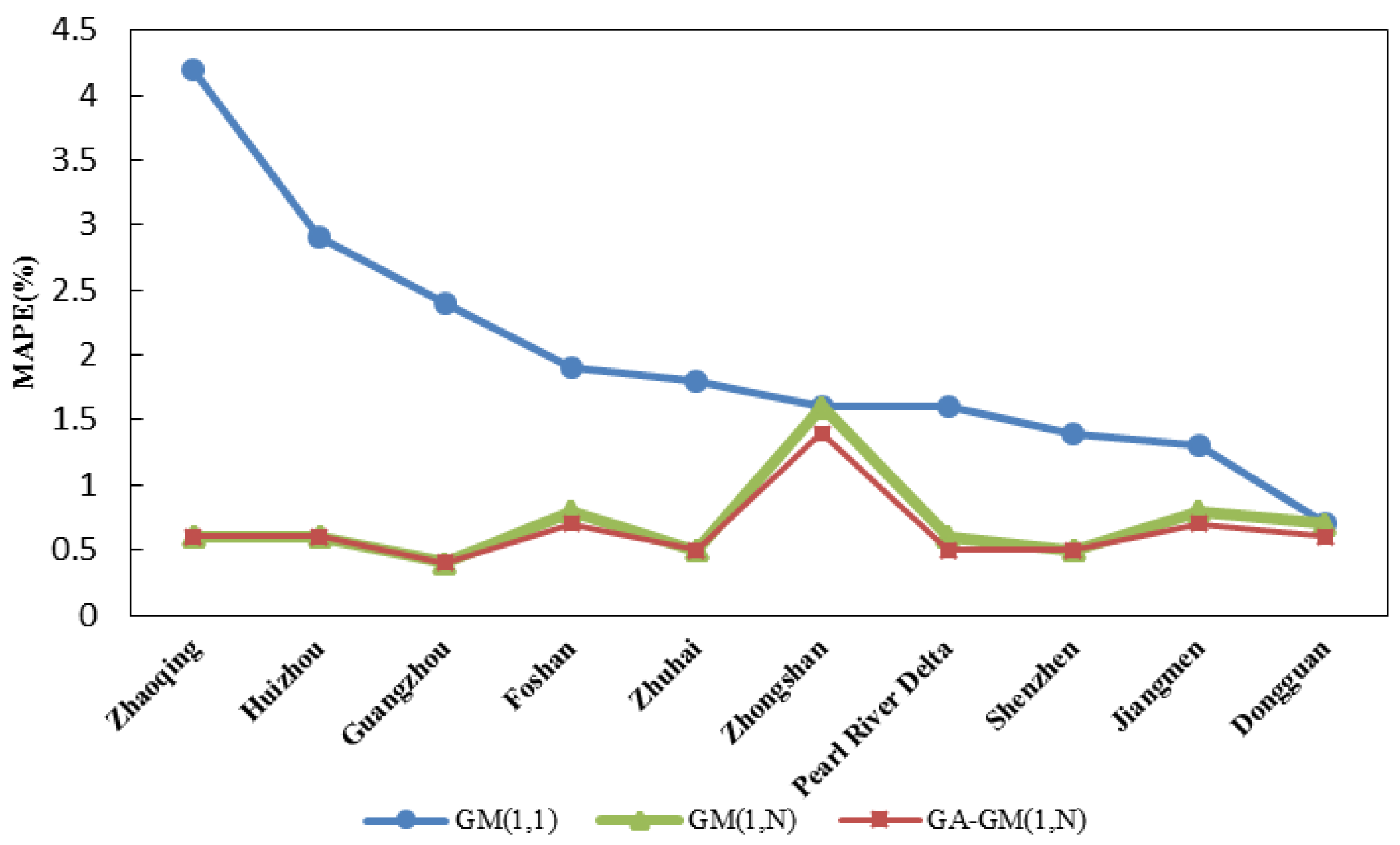

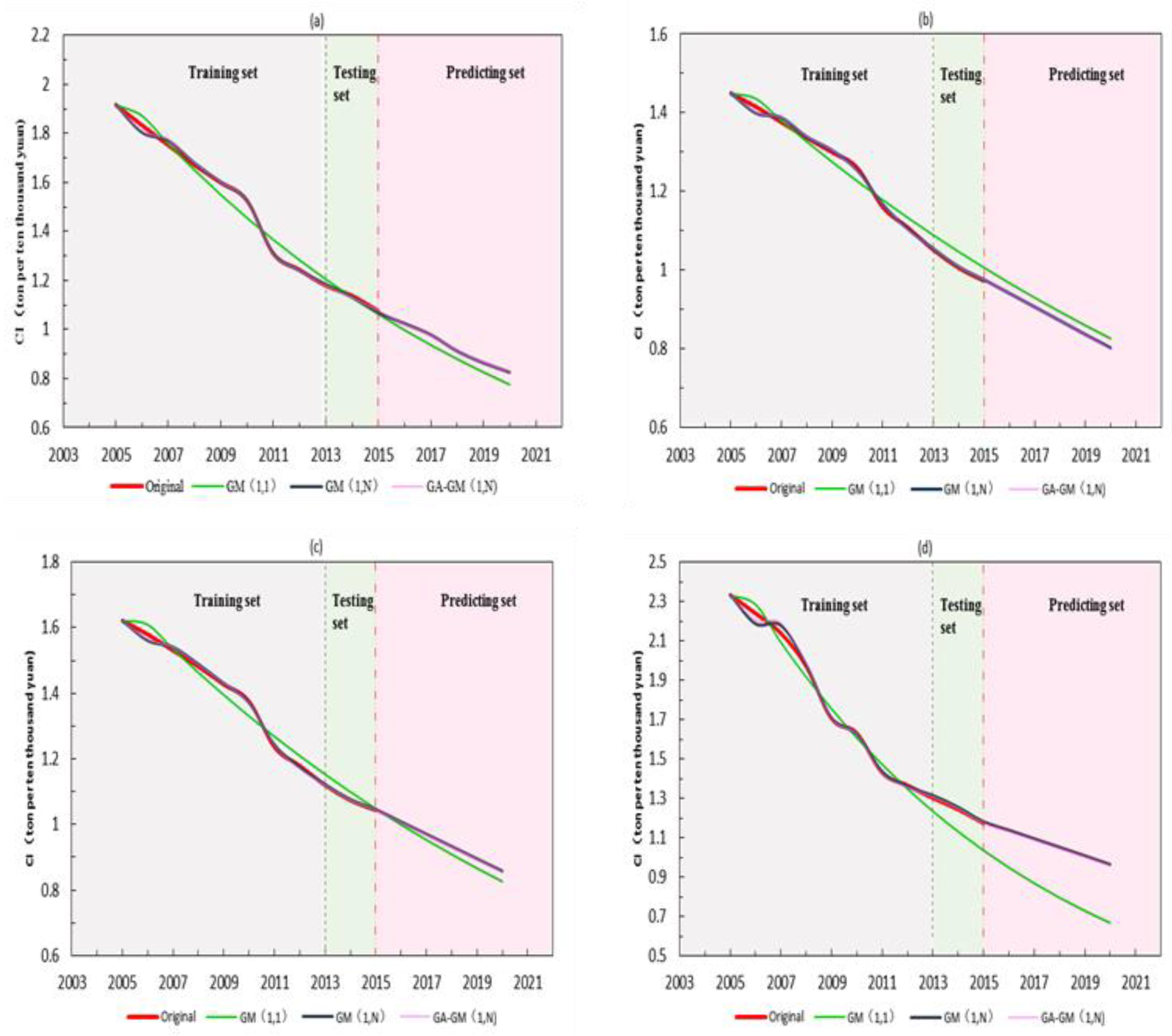
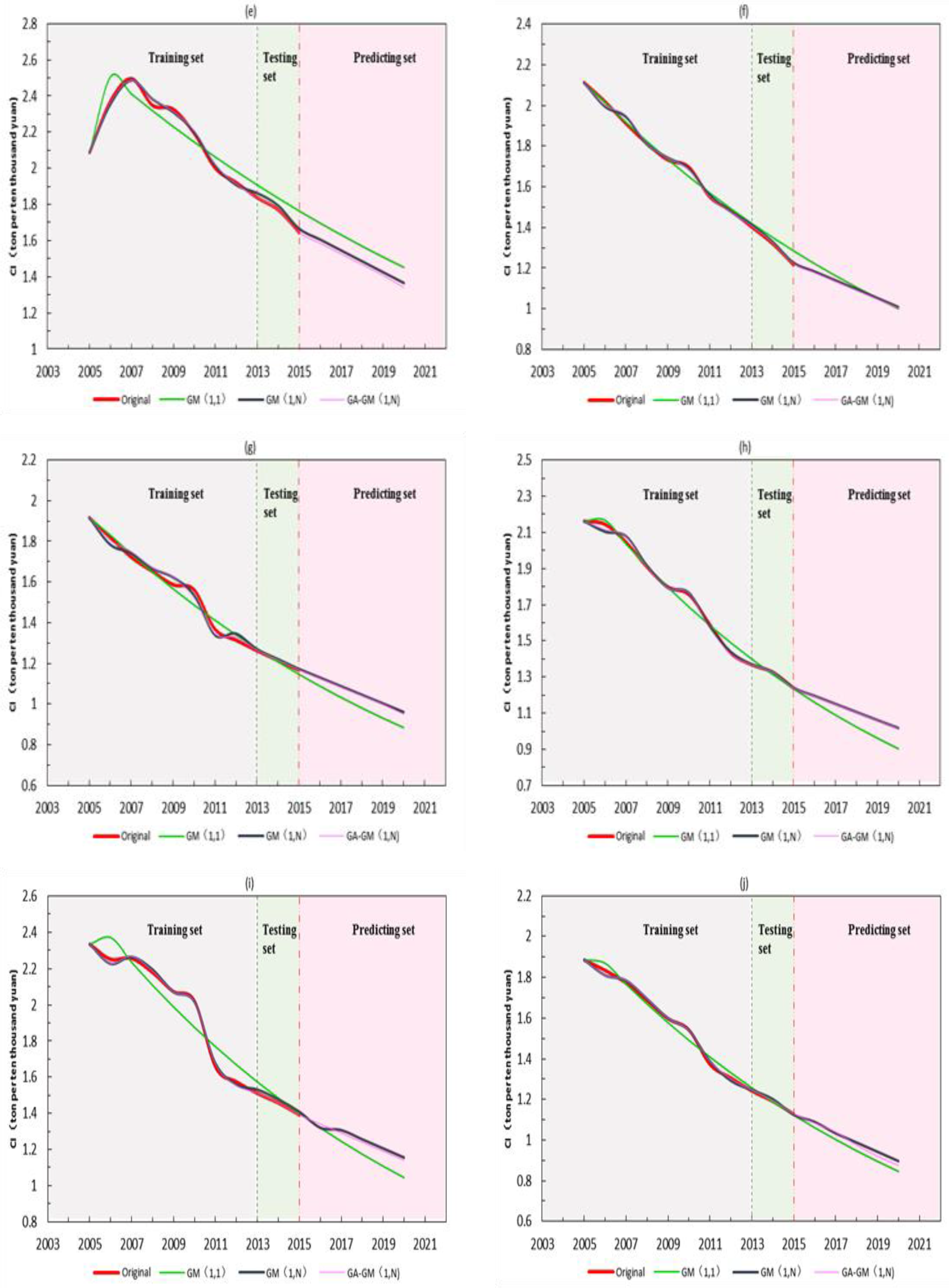
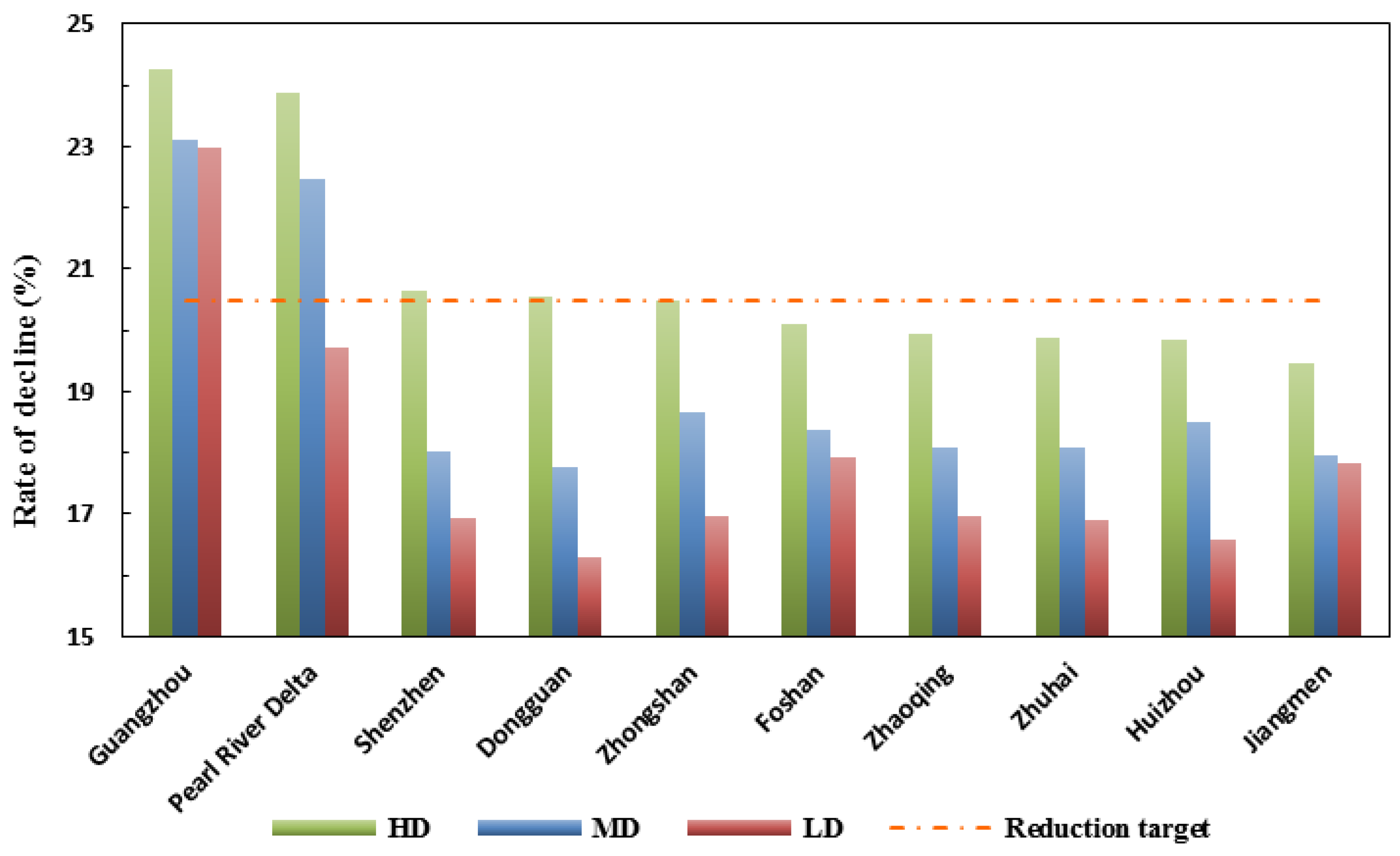
| Parameters | Value |
|---|---|
| Population size | 100 |
| Iteration times | 1000 |
| Crossover chance | 0.7 |
| Mutation chance | 0.1 |
| Region | GDP | Population | Energy Consumption | Industrial Structure |
|---|---|---|---|---|
| Guangzhou | 0.63 | 0.59 | 0.55 | 0.6 |
| Shenzhen | 0.62 | 0.56 | 0.53 | 0.81 |
| Zhuhai | 0.65 | 0.56 | 0.57 | 0.53 |
| Foshan | 0.54 | 0.52 | 0.59 | 0.56 |
| Huizhou | 0.67 | 0.52 | 0.56 | 0.52 |
| Dongguan | 0.6 | 0.64 | 0.61 | 0.63 |
| Zhongshan | 0.65 | 0.63 | 0.58 | 0.66 |
| Jiangmen | 0.61 | 0.52 | 0.54 | 0.61 |
| Zhaoqing | 0.69 | 0.65 | 0.58 | 0.6 |
| Pearl River Delta | 0.62 | 0.51 | 0.54 | 0.57 |
| Region | GDP | Population | ||
|---|---|---|---|---|
| LD | MD | HD | ||
| Guangzhou | 7.2 | 7.5 | 7.8 | 3 |
| Shenzhen | 7.2 | 7.5 | 7.8 | 4 |
| Zhuhai | 8.7 | 9 | 9.3 | 2 |
| Foshan | 7.2 | 7.5 | 7.8 | 4 |
| Huizhou | 9.2 | 9.5 | 9.8 | 3 |
| Dongguan | 7.7 | 8 | 8.3 | 3 |
| Zhongshan | 8.5 | 8.5 | 8.5 | 4 |
| Jiangmen | 8.7 | 9 | 9.3 | 4 |
| Zhaoqing | 8.7 | 9 | 9.3 | 3 |
| Pearl River Delta | 7.2 | 7.5 | 7.8 | 3 |
© 2018 by the authors. Licensee MDPI, Basel, Switzerland. This article is an open access article distributed under the terms and conditions of the Creative Commons Attribution (CC BY) license (http://creativecommons.org/licenses/by/4.0/).
Share and Cite
Ye, F.; Xie, X.; Zhang, L.; Hu, X. An Improved Grey Model and Scenario Analysis for Carbon Intensity Forecasting in the Pearl River Delta Region of China. Energies 2018, 11, 91. https://doi.org/10.3390/en11010091
Ye F, Xie X, Zhang L, Hu X. An Improved Grey Model and Scenario Analysis for Carbon Intensity Forecasting in the Pearl River Delta Region of China. Energies. 2018; 11(1):91. https://doi.org/10.3390/en11010091
Chicago/Turabian StyleYe, Fei, Xinxiu Xie, Li Zhang, and Xiaoling Hu. 2018. "An Improved Grey Model and Scenario Analysis for Carbon Intensity Forecasting in the Pearl River Delta Region of China" Energies 11, no. 1: 91. https://doi.org/10.3390/en11010091
APA StyleYe, F., Xie, X., Zhang, L., & Hu, X. (2018). An Improved Grey Model and Scenario Analysis for Carbon Intensity Forecasting in the Pearl River Delta Region of China. Energies, 11(1), 91. https://doi.org/10.3390/en11010091





